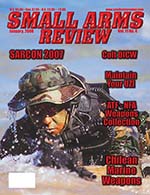The National Firearms Collection of the Bureau of Alcohol, Tobacco, Firearms, and Explosives (ATF) has a long and interesting history, spanning several decades.
- 1920s-1930s: The predecessor agency of ATF, the Bureau of Prohibition, began seizing firearms from bootleggers and other criminals during the Prohibition era. Some of these firearms were kept as evidence or for training purposes, forming the beginnings of what would eventually become the National Firearms Collection.
- 1934: The National Firearms Act was passed, which required the registration of certain types of firearms, including machine guns and short-barreled rifles and shotguns. As a result, the Bureau of Prohibition began collecting these firearms for registration purposes, further expanding the collection.
- 1935-1968: The Bureau of Alcohol, Tobacco, and Firearms (ATF’s predecessor) continued to collect firearms from criminals, as well as from individuals who voluntarily surrendered their firearms. During this time, the collection grew in size and diversity, encompassing a wide range of firearms from around the world.
- 1968: The Gun Control Act was passed, which regulated the sale and transfer of firearms and expanded the types of firearms that were subject to registration. As a result, the National Firearms Collection grew even larger, with ATF continuing to seize firearms from criminals and to accept firearms surrendered by individuals.
- 1972: The National Firearms Act Branch of ATF was established to oversee the registration of firearms subject to the National Firearms Act. The National Firearms Collection was placed under the jurisdiction of the National Firearms Act Branch, which was responsible for maintaining and cataloging the collection.
- 1982: The National Firearms Collection was moved from its original location in Washington, D.C. to a new facility in West Virginia, where it remains today. The move allowed for better preservation and storage of the firearms in the collection.
- 1993: The Brady Handgun Violence Prevention Act was passed, which required background checks for firearms purchases. ATF began collecting firearms surrendered by individuals who were prohibited from owning firearms under the new law.
- 2004: The Firearms Technology Branch of ATF was established to provide technical support to law enforcement agencies and to regulate the importation of firearms. The Firearms Technology Branch also became responsible for overseeing the National Firearms Collection, which included many firearms that were of historical or technical interest.
- Today: The National Firearms Collection remains an important resource for ATF, as well as for researchers, historians, and law enforcement agencies. The collection is regularly used for training and research purposes, and is occasionally displayed to the public at events such as the National Firearms and Ammunition Collectors’ Exhibition.
- more than 10,000 serial numbered items
- in West Virginia
- custodian is ATF’s Firearms Technology Industry Services Branch (FTISB)
- 1931 first compiled by the Bureau of Internal Revenue (later IRS)
- July 1972 collection transferred to ATF
- “National Firearms Collection” (NFC)
- rare, one-of-a-kind prototypes
- first run samples
- failed industry ideas
- highly collectible once-transferable ordnance pieces
- firearms and ammunition reference library
http://www.smallarmsreview.com/display.article.cfm?idarticles=1420
Small Arms Review V11N4 (January 2008)4
(Visited 92 times, 1 visits today)
